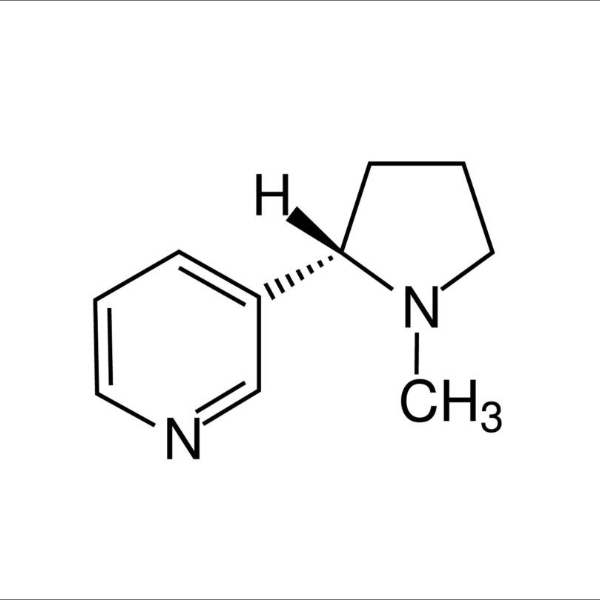Background Research

Nicotine (C₁₀H₁₄N₂)
According to the National Cancer Institute, a tobacco cigarette is a product that is mainly created from tobacco. It is shaped in a cylindrical shape, and inside it, there are cut and cured tobacco leaves. It is all wrapped in thin paper, mostly rolling paper. According to the American Lung Association (2020), tobacco cigarettes contain more than 600 substances, and when it is burned, they produce more than 7000 substances. More than 69 substances from tobacco cigarettes are carcinogens or substances that can cause cancer.
The three main components of all 7000 substances are nicotine, tar, and carbon monoxide. Nicotine is the substance found in tobacco that causes addiction and pleasure. The pleasing effects are temporary. Thus it makes the smoker reach for another cigarette and never stops smoking. Next is tar. Tar is a substance that creates stains in the smoker's teeth and fingers. It contains carcinogens or substances that can cause cancer. Besides that, it can damage the bronchioles, the small tubes in our lungs, and cilia, the tiny hair in our lungs. If we keep consuming tar, it can lead to chronic obstructive pulmonary disease (COPD) and emphysema. The last substance is carbon monoxide. Carbon monoxide is a toxic gas, usually found in vehicles, which replaces the oxygen in the blood. It makes the heart and lungs work harder, and the cells in our body do not receive the oxygen needed. Inhaling carbon monoxide will lead to diseases like stroke and baby miscarriage.

Nicotine (C₁₀H₁₄N₂)


According to Medical News Today, an electronic cigarette is a device that produces a vaporized solution, mostly nicotine, to be inhaled. It stimulates the sensation of smoking tobacco cigarettes but without the smoke.
Electronic cigarettes have three main components: battery, atomizer, and e-liquid or e-juice. There are three common types of batteries for electronic cigarettes. The first is disposable. Some electronic cigarettes, mostly the old ones, have a limited lifespan. Thus, they need to be thrown away after being used, and they are not rechargeable. The second one is integrated. The cigarettes that use this battery cannot be replaced or removed, but different from disposable, integrated batteries can be recharged even though they can only be recharged at certain times. The last type is removable. This type of battery can be recharged and replaced or removed after they no longer recharged. The second component of electronic cigarettes is the atomizer. An atomizer is a device to heat the e-liquid and convert it into a gas. The atomizer consists of a metal coil and a wick. The process of how it works is such: the battery heats the metal coil, and the e-liquid gets absorbed into the wick and gets heated. After being heated, the e-liquid will turn into a gas through evaporation. The last component is e-liquid. E-liquid is the liquid that gets heated and converted into aerosol or gas. The main ingredients of e-liquid are water, nicotine, flavorings, and propylene glycol or vegetable glycerin base.
There are several differences between tobacco and electronic cigarettes. The first difference is how they work. Tobacco cigarettes produce smoke by burning tobacco. On the other hand, electronic cigarettes produce aerosol or gas by heating the e-liquid inside the cigarette. The second difference is the toxins in both cigarettes. According to Scott Roberts Law (2021), tobacco cigarettes are way more toxic than electronic cigarettes. The tobacco itself is toxic when burnt. It contains hundreds of toxic chemicals and several carcinogenic chemicals. Meanwhile, electronic cigarettes are healthier than tobacco cigarettes, even though they are still harmful. The e-liquid does not contain any harmful chemicals like tobacco, and all of the ingredients are not toxic when vaporized. The other difference is the cost of cigarettes. Tobacco cigarettes are generally cheaper than electronic cigarettes. Besides that, electronic cigarettes need more cleaning and maintenance than tobacco cigarettes.
According to the Centers for Diseases Control and Prevention (2020), smoking can lead to several severe diseases in almost all organs in our body. It can cause cancer, heart disease, stroke, lung diseases, diabetes, and chronic obstructive pulmonary diseases (COPD), like emphysema and chronic bronchitis. Besides that, smoking cigarettes can increase the risk of tuberculosis, several eye diseases, problems in the immune system, and rheumatoid arthritis. Passive smoking can also affect health. About 41,000 people died due to passive smoking or secondhand smoking. In addition, there are 400 deaths of infants (babies) every year. Besides causing diseases, smoking can cause addiction. Addiction is caused by nicotine. When we consume nicotine, our brain releases dopamine. It is the chemical that gives pleasure. When the effect of nicotine starts to disappear, the brain will release more dopamine. The more we smoke, our sensitivity will decrease. To feel good, we need more dopamine than before. This situation will make us hard to stop smoking.
According to Badan Pusat Statistik (BPS), 3.69% of the teenagers in Indonesia (age below 18) smoked both tobacco and electronic cigarettes in 2021. From 2015 to 2021, the trend line of smokers is stable, except for 2018. In 2018, there was a big blast, at 9.65%. According to analysis, this blast can happen because the Indonesian government just legalized vaping. This creates a trend about vaping, thus increasing the number of teenagers smokers in Indonesia. 16-18 have the highest percentage when classified into several age groups, at 9.59%, followed by 13-15, at 1.44%. Last is 10-12 at 0.07%. We think that this number is a lot. According to Badan Pusat Statistik (BPS), the number of people below 18 is 88400000. If 3.69% of them smoked, there would be 3261960 people smoking. Even though the percentage is small, it does not mean that the result will be small either.
According to FAKTOR-FAKTOR PENYEBAB PERILAKU MEROKOK PADA REMAJA (Komasari & Helmi, 2015), there are 3 main reasons why teenagers in Indonesia smoke. The first reason is psychological satisfaction. When first trying to smoke, they usually experience unpleasant symptoms like coughs, tongue tastes bitter, and stomachache. However, they tend to ignore them and continue building up this habit, which later becomes an addiction. This addiction is perceived as comfort and pleasure, which creates psychological satisfaction. From a fun thing to do, smoking has become an obsessive activity. This addiction can happen because of nicotine. The second reason is family. If one family member smokes, they will be a good imitation agent for teenagers to smoke. On the other hand, if none of the family members smoke and there are permissive parents, their kids will tend to smoke. The last reason is friends. Friends, especially those of the same age, have an essential role in teenagers' development. They will usually do anything to join their friends' group or gang. Besides that, smoking is one of the symbols of masculinity and strength. Thus, if one of the friends does not smoke, they will be effeminate and sissy. Lastly, friends are one of the agents that first introduce what smoking is to teenagers.


